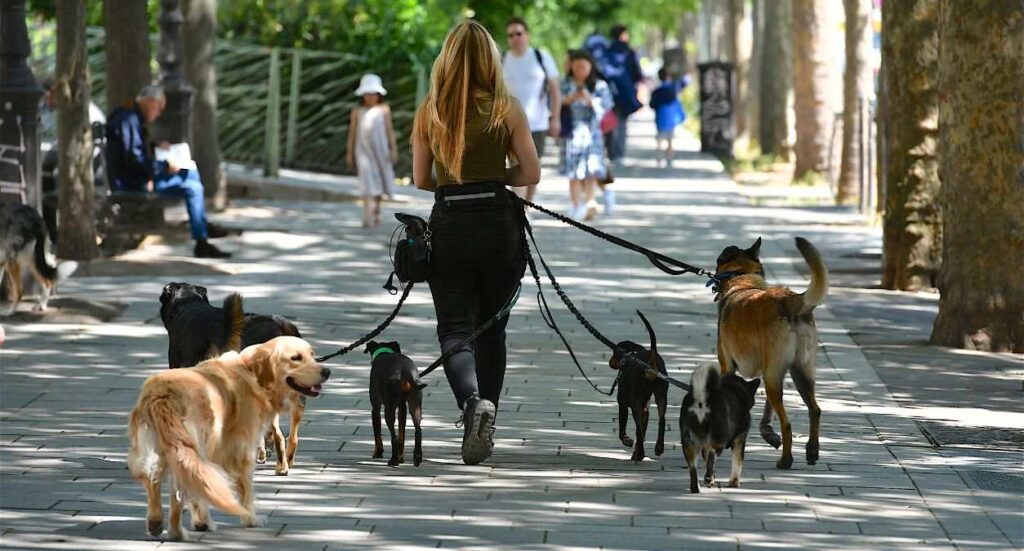Table of contents
Let’s face it, dogs can do things that really test our patience. Whether it’s barking at the postie, digging up the garden, or ignoring recall entirely, it’s easy to label them as naughty. But here’s the truth: “Behaviour is communication – not manipulation or dominance.”
Pet experts Sian Lawley-Rudd, an ethical dog trainer at Lavender Garden Animal Services and Sadie Geoghegan-Dann, dog trainer and carer at Nervous Rex help us understand what a dog’s behaviour is trying to tell us.
When we pause to ask why a behaviour is happening, everything shifts. We move from frustration to empathy, from reacting to responding. Because behind every so-called “bad” behaviour is a message and one that deserves to be heard.
Let’s break it down and start decoding what your dog is really trying to say.
Common “problem behaviours” and what they really mean
Understanding dog behaviour is not about control — it’s about connection. Many behaviours that humans see as “problems” are actually forms of communication. Each of the following types of behaviours have common reasons behind them and simple training approaches you can follow.
Excessive barking
Dogs bark to express emotions; excitement, anxiety, boredom, or frustration. Some dogs are more sensitive to sounds, and deaf dogs may bark differently due to their altered perception of the world.
Training approach:
- Identify the cause: boredom, fear, or overstimulation?
- Increase mental stimulation through enrichment.
- Use desensitisation to reduce reactivity to triggers.
- Reinforce quiet behaviour using treats or praise.
Advice:
“Take note of the pitch, rhythm, and context. And if barking is sudden or excessive, check with your vet to rule out pain or distress.”
Growling
Growling is a warning, a healthy form of communication that says, “I’m uncomfortable.” It helps prevent bites by letting you know there’s a problem.
Training approach:
- Don’t punish the growl; investigate the trigger.
- Create space and make your dog feel safe.
- Use counter-conditioning to change their emotional response over time.
Advice:
“Never punish a growl – understand why your dog is growling. Remember: dogs also growl during play. Context is everything.”
Chewing & destruction
While puppies chew to soothe teething pain, adult dogs often chew due to stress, anxiety, boredom, or lack of stimulation.
Training approach:
- Provide appropriate chew toys and rotate them regularly.
- Ensure your dog is mentally and physically stimulated.
- Use redirection rather than punishment.
- For sudden destruction, consult a vet to rule out medical causes.
Advice:
“Destructive behaviours often come from unmet needs or stress – not mischief.”
Begging
Begging is a learned behaviour, if it’s been rewarded even once, dogs will try it again. It’s not stubbornness, but effective communication.
Training approach:
- Avoid feeding from the table or while eating.
- Reinforce calm behaviour with treats away from the table.
- Stick to a regular feeding routine and ensure your dog’s needs are being met.
Advice:
“Dogs repeat behaviours that work. It’s not defiance – it’s communication.”
Resource guarding
This behaviour usually stems from anxiety or past experiences. If a dog has had food, toys, or even affection taken away suddenly, they may feel the need to guard it.
Training approach:
- Don’t grab items forcibly – this can escalate fear.
- Teach a “trade” using high-value rewards.
- Allow space during meals or rest.
- Work with a behaviourist if the guarding is severe.
Advice:
“Resource guarding stems from anxiety. Trust is a key element to this.”
Digging
Dogs dig for many natural reasons: to cool off, search for scents, bury things, or simply entertain themselves. Some breeds are genetically more inclined to dig.
Training approach:
- Create a designated digging area (like a sandpit).
- Bury toys or treats there to encourage appropriate digging.
- Increase physical and mental stimulation to reduce boredom.
Advice:
“Suppressing a dog’s need to dig can bring out other problem behaviours.”
Nipping, mouthing & biting
Puppies explore the world with their mouths. Older dogs may nip when overstimulated or frustrated. Biting is typically a last resort communication when warnings (like growling) are ignored or punished.
Training approach:
- Teach bite inhibition early.
- Redirect nipping to toys or chews.
- Avoid overstimulating games like rough play.
- Monitor for stress signals and offer calm breaks.
Advice:
“Nipping is exploration; biting is a last resort on the ladder of communication.”
Inappropriate toileting
Toileting inside is often the result of confusion, anxiety, health issues, or inconsistent routines, not deliberate disobedience.
Training approach:
- Keep a consistent toilet schedule.
- Reward toileting in the right place.
- Avoid punishment – it can cause fear and worsen the problem.
- Rule out medical issues with a vet if there’s a sudden change.
Advice:
“You should never tell a dog off for toileting inside – it just instils fear.”
Recall problems
Poor recall doesn’t mean your dog is ignoring you out of spite. Usually, the environment is simply more rewarding than you are in that moment.
Training approach:
- Make coming back fun: use toys, treats, praise.
- Practise in low-distraction environments first.
- Build trust and engagement through games.
- Understand your dog’s breed needs – some dogs are more independent by nature.
Advice:
“Recall is relationship. Dogs don’t ignore us out of spite, they need motivation and trust.”
Recognising behavioural patterns
Understanding why a dog behaves the way it does starts with recognising the patterns in their body language and reactions. Knowing what you’re looking at is half the battle.
Anxious dogs might: pace, pant, freeze, cower, avoid walks, or show hyper-vigilance.
Reactive dogs might: bark, lunge, redirect frustration, freeze, or escalate quickly.
Under-socialised dogs might: bark excessively, ignore social cues, become over-attached, or seem overly intense.
Training
Why force-free training prevents behavioural issues
“Force-free, ethical training doesn’t just teach puppies how to behave, it helps them feel safe, understood, and confident.”
Using positive reinforcement from the start sets puppies up for long-term emotional and behavioural wellbeing. Here’s how it makes a difference:
- They learn what’s okay to chew early on
- They gain confidence through gentle socialisation
- Recall becomes a fun, rewarding game
- They handle alone time better, with fewer anxiety issues
- Their needs are met through enrichment like sniffing, licking, and problem-solving
At its core, force-free training is about building partnership, not control. When dogs trust us, they’re far more likely to learn and thrive.
10 ways to build a calm, connected relationship with your dog
“Calm isn’t something you command – it’s something you co-regulate.”
- Pause before labelling: Don’t jump to conclusions; ask why before reacting.
- Meet their whole needs: Physical exercise, mental stimulation, and emotional security all matter.
- Prioritise decompression walks: Let them sniff, explore, and move at their own pace.
- Build trust before obedience: A strong bond is the foundation of cooperation.
- Train through play: Learning sticks best when it’s fun and rewarding.
- Socialise gently and gradually: Respect their limits; quality over quantity.
- Keep routines predictable: Structure reduces stress and helps dogs feel secure.
- Reward generously and often: Reinforce the behaviours you want to see more of.
- Offer choices when you can: Autonomy builds confidence and reduces conflict.
- Stay calm and grounded: Your dog takes cues from your energy.
Understanding creates compassion
When we shift our perspective and start seeing dog behaviour as communication rather than defiance, everything changes. We stop trying to control and start trying to connect.
Dogs aren’t trying to dominate us, they’re trying to feel safe, supported, and understood. Whether it’s barking, digging, or ignoring a recall, there’s always a reason behind the behaviour.
So next time your dog does something unexpected, pause and ask: “What might they be trying to tell me?”
And remember – sudden changes in behaviour can be a sign of pain, illness, or distress. When in doubt, always check in with your vet. A compassionate response starts with curiosity, not correction.
Get Pet Business Insurance from Protectivity
*Disclaimer – This blog has been created as general information and should not be taken as advice. Make sure you have the correct level of insurance for your requirements and always review policy documentation. Information is factually accurate at the time of publishing but may have become out of date.
Last updated by
















